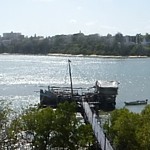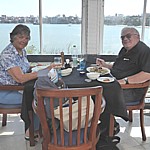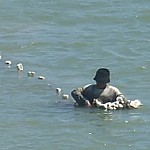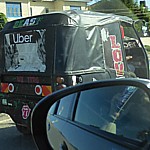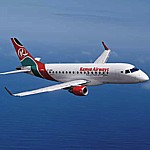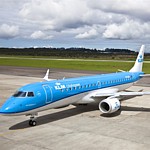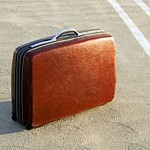James & Carol's visit to Kenya
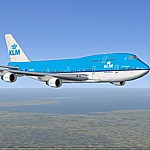
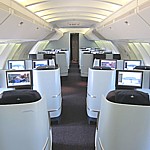
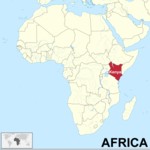

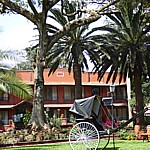

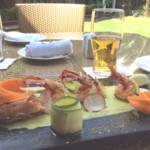
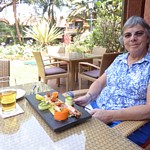
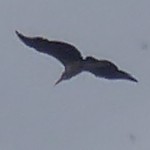

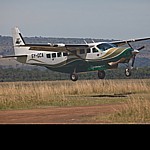
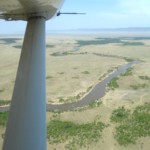
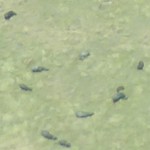
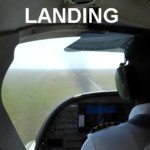
The Maasai Mara National Reserve (also known as Maasai Mara, Masai Mara and by the locals as The Mara) is a large game reserve
in Narok County, in the West of Kenya, contiguous with the Serengeti National Park in Mara Region, Tanzania.
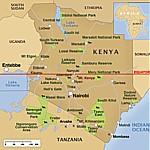
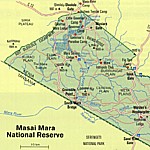
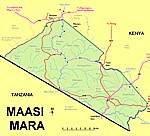
Thee Maasai Mara National Reserve is named in honor of the Maasai people (the ancestral inhabitants of the area) and their description
of the area when looked at from afar: "Mara," which is Maa (Maasai language) for "spotted," an apt description for the circles of trees,
scrub, savanna, and cloud shadows that mark the area. It is globally famous for its exceptional population of lions, leopards and cheetahs,
and the annual "Great Migration" of zebra, Thomson's gazelle, and wildebeest to and from the Serengeti across the Mara River.
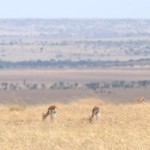
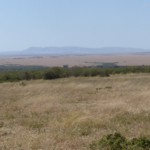
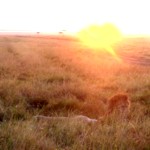
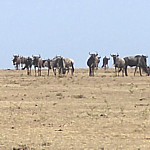
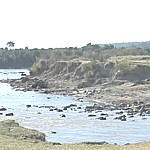
We landed at Musiara Airport, a dirt airstrip near the Musiara Marsh - made famous in the BBC's "Big Cat Diary" - and were met by our guide,
Enos, from Governors' Il Moran Camp (which is where the BBC stayed). We drove to the camp and were shown our tent, which was right beside the
Mara River with hippopotamuses and crocodiles only yards away. At night the hippos were even closer - right outside! And also baboons, elephants,
hyenas, jackals and the occasional lion. We did not walk outside the tent at night without an (armed) escort.
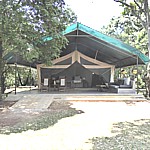
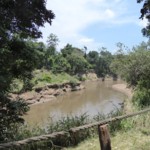
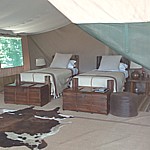
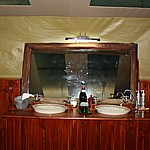
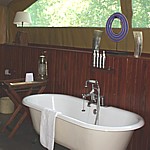
After an excellent lunch, during which we met the camp's resident warthogs and Stephen and Laura, our fellow game drive passengers,
a honeymoon couple from Liverpool (James' home town), we had the first of our ten game drives. The Il Moran custom is to have three game
drives - the first leaves a little before sunrise, which means that one has to be up, tea'd or coffee'd (and biscuited) no later than
05:45 to leave around 06:00. This one ends with breakfast in the camp between 08:30 and 09:30 and is followed by a second drive before
lunch. The last drive of the day starts at 15:00-15:30 and ends with a drink, known as a "Sundowner", in the bush fairly near the camp
to watch the sunset at about 18:30. The Park Rules mandate that all game drives must have ended by 19:00. Dinner is at 19:30 and most
people go to their tents quite soon afterwards to be ready for their early start in the morning.
Enos, our guide, did not follow this schedule. With our agreement we had two drives per day instead of three, missed the sumptuous cooked
breakfast in camp, and instead had a picnic breakfast in the bush at about 09:00 and did not return to camp until Noon or even later.
This allowed us to travel much further from the camp and see things which would not have been possible if we had had to be back for breakfast,
but of course it did mean that we were spending nine or ten hours per day driving in an open (sunshaded) Land Cruiser on very bumpy dirt roads.
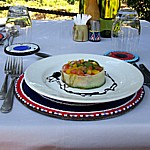
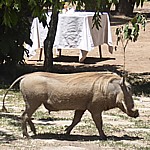

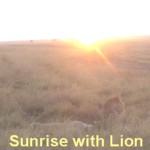
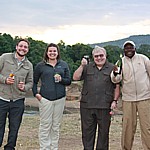
The Maasai Mara is at the northern end of the Serengeti ecosystem. The vegetation of this area provides food for many species of grazers,
from elephants, rhinoceros and hippopotamus to dik-diks. They are able to co-exist because each species prefers slightly different foliage.
For example, wildebeest prefer to consume shorter grasses, while zebras prefer taller ones. Similarly, the dik-dik eats the lowest leaves
of a tree, impalas eat the leaves that are higher up, and giraffes eat leaves that are even higher. As the weather changes with the seasons
many of the grazers move with the flourishing vegetation in the "great migration". Wildebeest, zebra and gazelle migrate in huge herds and
where they cross the Mara River they provide a major food source to the crocodiles living in the river. Crocodiles, being cold-blooded, can
survive long periods without food, storing fat in their tails in times of plenty against the months when few grazers cross the river.
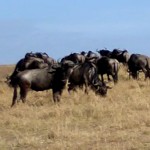
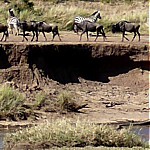
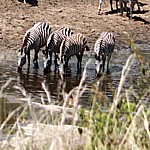
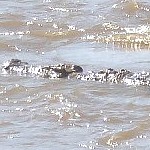
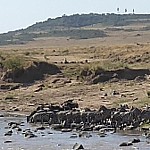


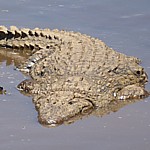


We saw three crossings, one of elephants. The other two were zebra crossings and both, surprisingly, were without crocodile kills despite about
a dozen crocodiles in the water nearby. Zebra seem to be faster than wildebeest and when crossing alone without wildebeest to impede them can
sometimes dodge the crocodiles' attacks. Adult elephants, of course, are rarely attacked by crocodiles and can protect their young when crossing.
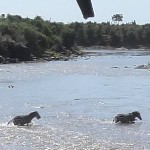
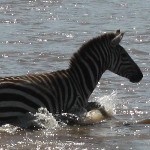
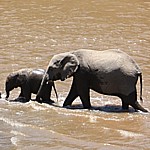

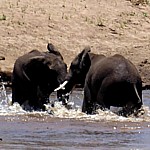
Of course we saw elephants, zebra and wildebeest that were nowhere near the river, and many other grazers: giraffe, buffalo, eland, waterbuck,
hartebeest, topi, impala, Thomson's gazelle (which are not the same animal as springbok, although they look very similar), warthogs (including
the ones in Il Moran Camp), and the tiny dik-dik (should not be confused with the tuk-tuk, which is a motor rickshaw - we saw them in Mombasa).
But although we saw lots of hippopotamuses we didn't see the rhinoceros.

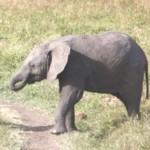
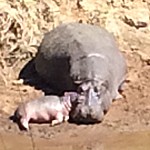


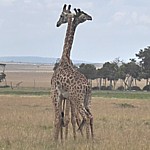
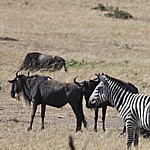
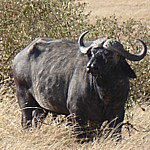
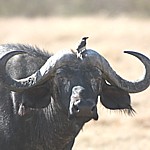


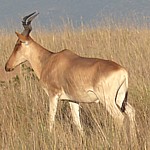
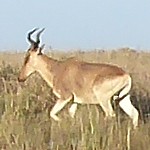
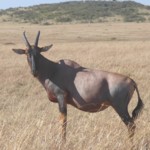

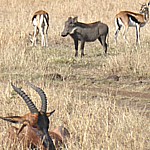
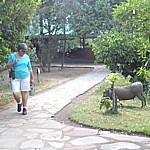

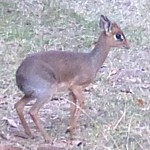

With all those large grazers there is, of course, a substantial population of large predators. The mammalian ones include lions, leopards,
cheetah, jackal and hyenas. We saw all of them - lions and hyenas very frequently (during the night they were often inside the camp -
but not inside the tents - we heard them there but did not see 'em). Leopards and jackals are also common, but leopards, being stealth
hunters are rarely seen - we only saw the one. Cheetah are scarcer but we saw several. Here are a few of our predator photographs - the
warthog is teasing the leopard, despite the danger, to distract her from the piglets hiding nearby, as are the jackals teasing the pack
of hyenas to distract them from their puppies in a hole nearby.
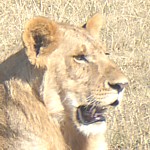
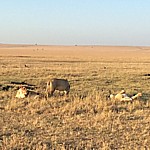
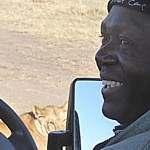
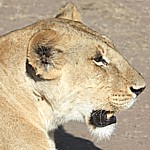

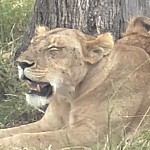
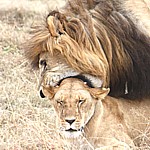
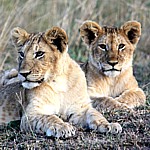

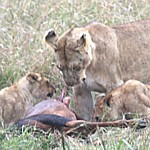
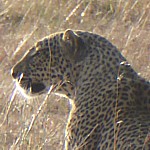
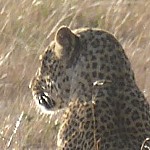
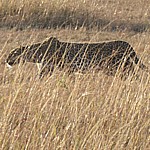
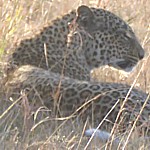
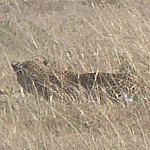
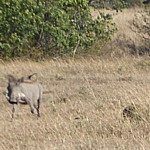
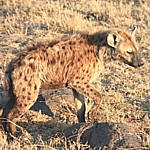

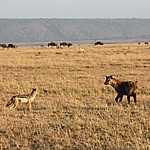
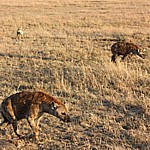
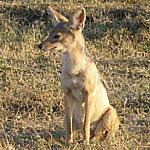









On a safari of this type one sees some smaller animals, but it is somewhat opportunistic. Our (very optimistic) list of ones we would like
to see (but didn't) during our drives included aardvark, bat-eared fox, genet, honey badger, pangolin and serval, but we did see banded and
dwarf mongoose, baboons, a monitor lizard, and a spitting cobra. In Mombasa we added several types of lizard, a camel and vervet monkeys.
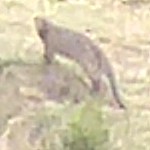
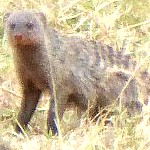
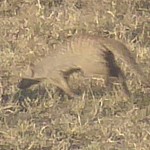



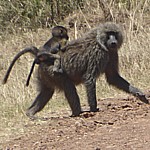

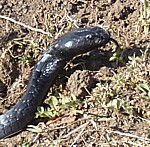
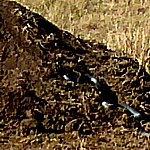

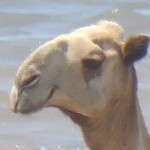

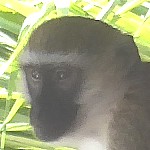
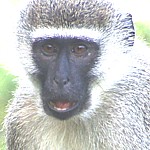
Of course we also saw innumerable birds ("Birds of East Africa" lists over 1,300 species)- and photographed quite a lot of them. But we
haven't identified many of them (Enos did - but we didn't make notes in a safari van and have forgotten most of them, alas). Here are a
few we can identify, followed by the prettiest of the others - if you're an expert and can identify them please tell us what they are.
If you are a serious birder and want to see all the birds we photographed they're at www.jbryant.eu/BS.ZIP (~200MB) - please look. These
files have not been photoshopped and are as taken, they have, however been reduced in size from 4000 pixels on the long side to 1600 -
if you want the large copy of any please ask me for it. If you let me know the details of any you identify I'll add 'em to this page.
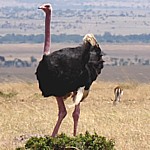
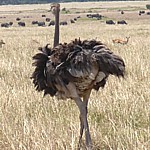

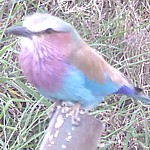
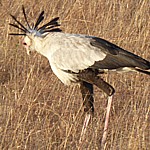
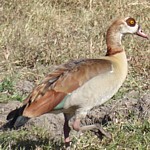

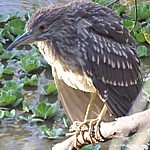
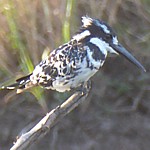
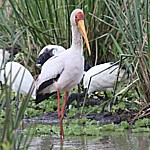

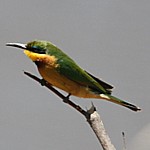
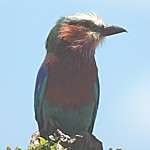
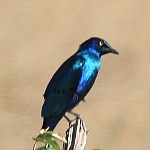
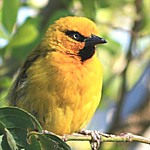
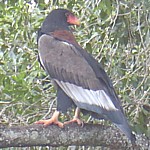
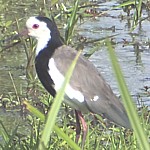

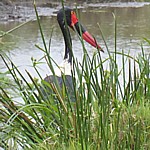
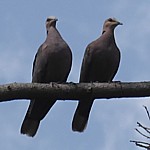
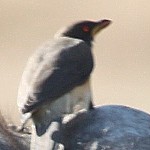
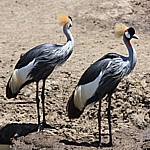
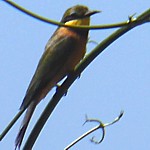
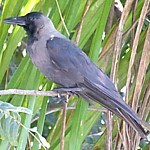

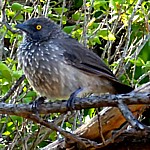

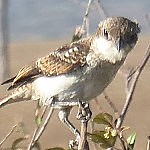

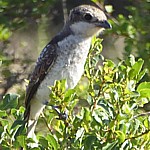
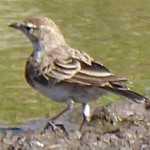
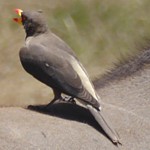
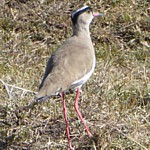
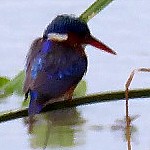
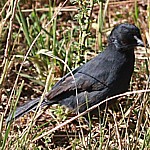
We stayed at Governors' Camp for five nights and on our last game drive, the morning we left, we excelled ourselves, seeing no less than
sixteen lions - fourteen in one pride - and at least one of all the grazers I listed previously. After lunch we went back to Musiara
airstrip and took another Cessna to Mombasa, where we planned to recover from all our early rising with three days of relaxation on a
palm-fringed beach beside the Indian Ocean. Our flight took us near Mt Killimanjaro but the sky was full of cumulus so we did not see it.
We landed at the main airport but went to the General Aviation Terminal, where we were met by a car from our hotel. One of our fellow
passengers was heading for the International Terminal a mile away but there were no taxis at the GA Terminal so we persuaded our driver
to give him and his heavy luggage a lift. On the way he advised us to visit a seafood restaurant on a beach several km North of Nyali.
Carol had stayed at the Nyali Beach Hotel twice in the early 1990's and had been impressed. Sadly, although the position, with a private
beach beside the Indian Ocean and tropical gardens, was still wonderful, and the hotel staff were as friendly and helpful as ever the
quality of the food and the efficiency of the service has deteriorated. It is still a very pleasant place to stay and James would go back
(though Carol wouldn't) but it no longer has the five star impact that it had almost thirty years ago. Today it is four star at best.
We spent most of our three days there relaxing beside the sea and in the bar. The Tusker, home-made bread, and curries were excellent,
even though the meat was tough, the fried eggs were scrambled, and the wine arrived after we had finished our meal. So on our third
day we went to the restaurant Monsoons near the Jumba Ruins about 17km North of our hotel for lunch. It is small and simple, right
on the beach and the seafood comes straight from the reef and is impeccably cooked. Carol had a simple Prawn Cocktail and Red Snapper
in an African sauce while James has Baked Oysters and then Octopus. The proprietor has an Italian husband and has travelled with him
to study cooking in Italy and Indonesia as well as at home in Mombasa - the results are wonderful. Eat there if ever you're nearby.

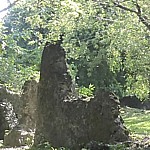
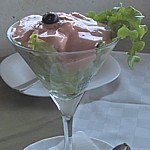
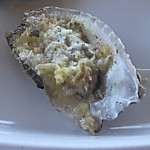
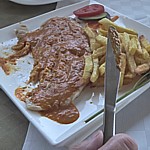
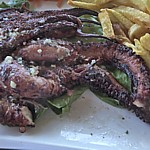
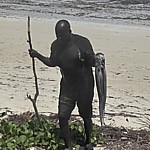
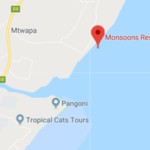
On Thursday we packed and went to the airport via Tamarind, a seafood restaurant on a cliff overlooking a lagoon and Mombasa City.
It was good, but not as good as Monsoons. On our way from there to the airport we passed a tuk-tuk (motor rickshaw) with an Uber
sign on it. If we had known we could we would have used it to go to the airport just to say we had! We checked our luggage through
to Southampton since Kenya Airways code share with KLM. From there it was Nairobi in an Embraer 190, Amsterdam in a 747-400, and
Southampton in another Embraer 190. We arrived in good order at 09:00 - but our luggage didn't arrive until the following morning.
